IFA 2016: Examining the Malaise of Bargain Basement Virtual Reality
by Dr. Ian Cutress on September 9, 2016 9:00 AM ESTBargain Basement, 1 + 2 + 3
#1: Feihong Industry Company Limited and the FXH-09
The first AIO-VR (all-in-one virtual reality HMD) was actually one of the better ones out of the set. For $100 sample price, coming down to $75 on 3000+ orders, the headset uses a Rockchip RK3288 SoC which we’ve seen in tablets before. It’s a four-core ARM Cortex-A17 design, running at up to 1.8 GHz, with Mali T760MP4 graphics. It barely powers a tablet, so you can imagine it does wonders in an AIO-VR.
Aside from the SoC, the headset uses a single 5-inch IPS Full-HD display, similar to a smartphone unit. The display actually quotes 72% NTSC, with 60 Hz and 1000:1 contrast ratio (I should be so lucky). The 2GB/16GB arrangement is on the low end, and to my surprise (or perhaps not) there is only 802.11n in this model, and I would bet that it is single stream as well. Battery comes in at 4000 mAh.
Other specifications include a mini-HDMI port, micro-USB for charging, 5V/2A charging supported, a bundled Bluetooth joypad, and a total device weight of 460g. It’s worth noting that this headset, like a number of others in this list, uses a modified version of Android. The Nibiru variant seems designed for VR interaction in this case.
The design is simple, as one might expect from an ODM (it’s up to the OEM/reseller to add the flair), and this headset goes above a number of others in this list – we have separate controls for IPD (inter-pupillary distance, as in the distance between the eyes because everyone is different) as well as screen positioning for eye-lens-screen focusing. The lenses move as one unit for IPD adjustments, in and out, but that is more than most.
There’s no counterweight on the rear, meaning that the whole 460 grams rests on the face, and the design uses the side pad for in-scene adjustments. The nose grip at the bottom certainly wasn’t complete, letting in light; however I was told that again it can be an OEM adjustment.
If it’s $75 for the OEM, by the time it hits the market it would be at least double that, once a few stickers, logos and distribution is added.
#2: rftech VRA009
If you have ever wanted to look like Geordie LaForge from Star Trek, the rftech might have something cheap enough for a bad costume. The VRA009 is their ODM solution, striking at the heart of the low cost.
It’s all in the specifications: an Allwinner F1C100A, which is a single ARM9-based 32-bit core ARM926EJ-S solution with an integrated VPU in the back end, but the dual 800x480 screens might be the catch. Fair play in actually using dual 3-inch Sharp LCD panels giving a total 800x960 resolution, but I wonder which would struggle the most: understanding the low pixel environment or the low-end GPU stretched to the limit.
The marketing image on the side showed a picture of the Hulk in the field of view, and quoted 3D play time of 4 hours, with an integrated ‘real 3D player’. I wonder if that’s 3D in the sense of pseudo applied 3D, or actual 3D content - but not the 120 Hz stuff as I’m pretty sure these are 30/60 Hz panels. Other specifications were not present, I was told I’d be sent a press kit but none arrived at the time of posting.
The black on blue visor look draws the eye to the design, and the AIO-VR puts all the buttons on the bottom. We get a full directional pad, a power/return button, a micro-USB for charging, and a slider indicating ‘2D/3D1/3D2’, which I can only assume is a slight adjustment for the lenses depending on the mode it is in. There is no IPD adjustment, with the lenses being fixed.
The inside of the VRA009 was also bathed in light when equipped (hunting for VR at these shows is like an RPG), with the leatherette surround instantly feeling uncomfortable and obviously prone to inducing sweat over long periods.
In this case, I’m sure that rftech is pitching this device purely for media content consumption. I doubt it could pass even basic 3D interactivity without inducing nausea, but that’s something that you have to play with when it comes to cheaper VR headsets.
#3: OMG Electronic Limited
No name for this particular AIO-VR, and no specs either, but it does a new thing that the other headsets haven’t done so far – per-eye IPD adjustments.
The styling is a basic black surround over a white chassis, which seems to be a common theme with these headsets. There’s space for the OEM/reseller to slap a logo on the front, and all the buttons are placed at the top.
Dual directional pads cater for practically everything in a very simple ‘here are some Android buttons and a d-pad’ implementation. The power button is extremely close to the volume down button, so I can imagine a user quite easily fumbling for it and accidentally turning the hardware off. Oops.
The bottom has the IPD adjustment sliders, and they were actually very smooth in their operation. When in position, tilting the headset did not adjust the arrangement, which is good to see (and something I might fear from a cheap headset). The bottom of the device also has a USB port, a microSD card slot, a 3.5mm jack for audio and what I believe is a mini-HDMI port as well.
Inside, the lenses look substantial bits of PMMA (polymethylmethacrylate) plastic, as there would be no glass here, with a woven spongy surround that feels a lot better than the leatherette of other devices. Again, there’s no real nose guard for stray light, leaving it up to the reseller to sort out.




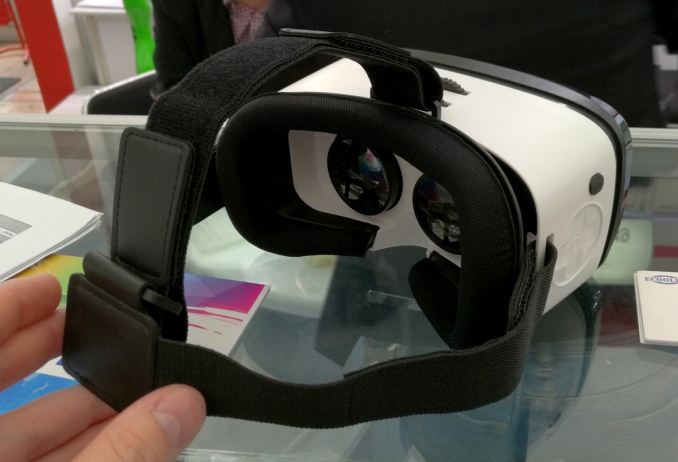









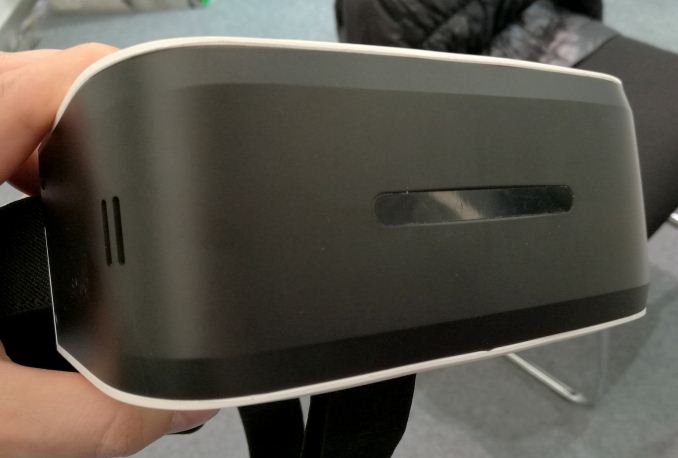
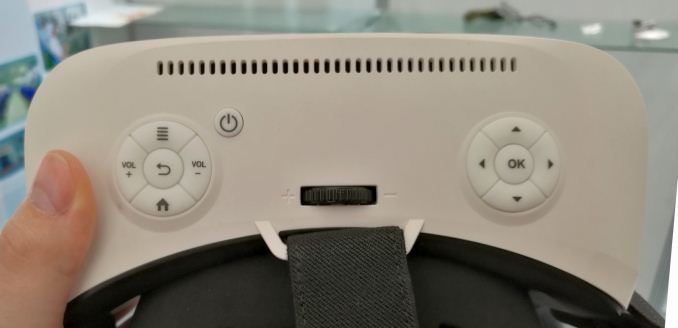
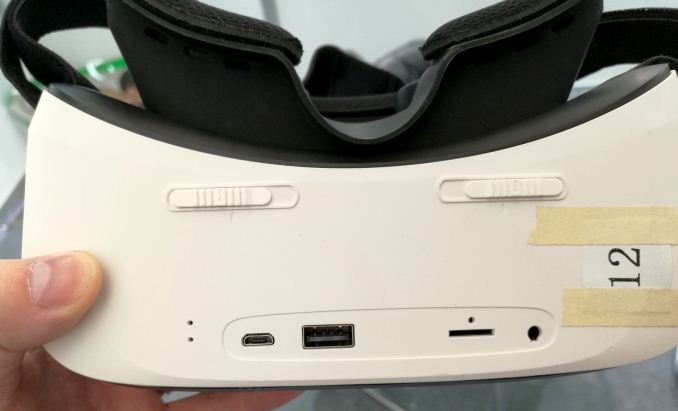
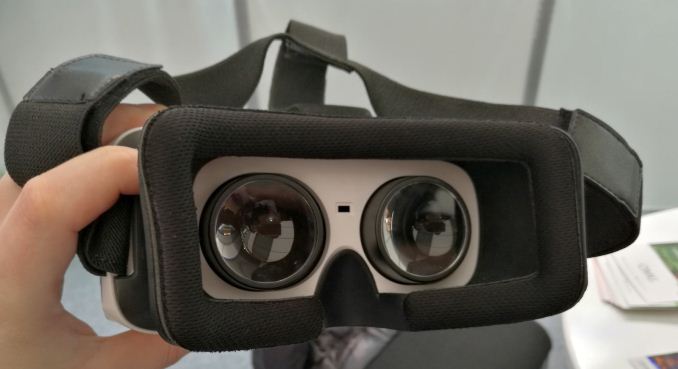








59 Comments
View All Comments
cocochanel - Saturday, September 10, 2016 - link
You could get a decent PC capable of VR for under a $1000. Say, a Zen + RX480 + 8Gigs RAM + SSD. Throw in an Oculus Rift for $600 and you're looking at around $1500. Where do you guys came up with the $3000 figure ? I suspect is the Nvidia camp who still insist that VR should start with a GTX 1080. C'mon.Death666Angel - Saturday, September 10, 2016 - link
Zen isn't out yet. Otherwise, yes, 3k is ridiculously overpriced for getting a VR ready setup.Icehawk - Saturday, September 10, 2016 - link
From testing I have seen online a 480 isn't close to enough firepower for VR at present the 1080 appears to be adequate and the Titan X is really the best option - and if VR takes off (it won't) even that hardware will likely be weak within a relatively short time frame. But I would agree $3k is being a bit generous, closer to 2k in reality with a 1080.Death666Angel - Saturday, September 10, 2016 - link
I haven't seen the same stuff as you then. All I read was in support of RX 480 being good enough for VR at this point in time. I don't argue that "more is better", but the benchmarks (Steam VR, people playing VR games @ 90fps) I have seen of the RX 480 and the minimum requirements of Oculus and HTC Vive point to the RX 480 being a good card for a VR ready PC. Any links would be appreciated. It's still tough to get dedicated VR tests from reliable websites. :)cptnjarhead - Thursday, September 15, 2016 - link
http://www.hardocp.com/article/2016/08/11/amd_nvid...From what i have read on hardocp VR reviews, the 480 has reprojection issues. Not sure if its DX11 related or not. But AMD needs to get it fixed cause right now the nvidia 1080 seems to be the only true "premium VR experience" . Not sure where all this liquid VR support is, but we are not seeing it.
Nagorak - Saturday, September 17, 2016 - link
The problem is UE4. It runs like crap on AMD hardware and it's not clear whether Epic is going to try to fix it, or if they're just going to laugh all the way to the bank where they cash nVidia's check.Half the games in VR are UE4. And, yes this hinders the experience on AMD immensely.
Nagorak - Saturday, September 17, 2016 - link
However there are still many games that do run alright on AMD. More horsepower is definitely better in VR, and that plus gimped UE4 means the best experience is sadly an Nvidia 970 and up. 290/390/480/X are still viable for many games but the experience suffers thanks largely to UE4.serendip - Saturday, September 10, 2016 - link
Cheap VR means no VR, at least for me. I've had enough of getting dizzy and vomiting after less than a minute of cheap Chinese VR "rides" that combine horrible low resolution displays and nausea-inducing movies with fast motion. All it takes is a few seconds of the eyes, inner ear and brain not syncing before lunch/dinner comes back up.I've also tried the Rift and Vive headsets. They're much more comfortable to wear and play on but the system cost and low overall resolution mean they're for hardcore gamers only for now.
Death666Angel - Saturday, September 10, 2016 - link
Using my hacked VRidge/Riftcat VR headset with 3D glasses (currently Fiit VR 2N) and my Nexus 6 works fairly well for 10 minutes (haven't bought the full version of the software yet and it only allows 10 minutes sessions in the free version). I can make myself sick by doing weird stuff in an Android roller coaster app though.Personally, I would need least 1080p 75Hz 5 - 5.5" with a gyroscope and a comfortable fit at under 200USD to consider this. The stuff I saw was either lacking too many features (resolution, tracking, refresh rate) or was too expensive (DK2 clone Deepoon E2 costs basically a little less than a used DK2 here, which is too much for me to consider a knock off).
DominionSeraph - Sunday, September 11, 2016 - link
"For the show this year"For what show?
You shouldn't write as though we've been following you around.